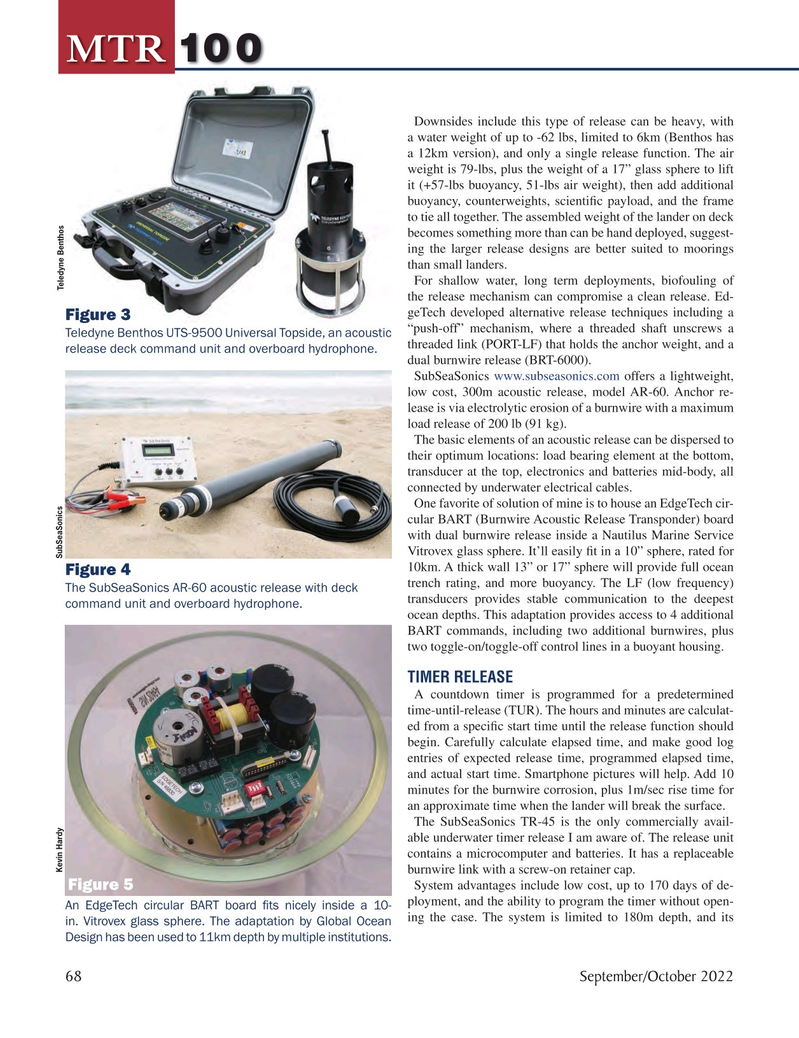
Page 68: of Marine Technology Magazine (September 2022)
Read this page in Pdf, Flash or Html5 edition of September 2022 Marine Technology Magazine
MTR 100
Downsides include this type of release can be heavy, with a water weight of up to -62 lbs, limited to 6km (Benthos has a 12km version), and only a single release function. The air weight is 79-lbs, plus the weight of a 17” glass sphere to lift it (+57-lbs buoyancy, 51-lbs air weight), then add additional buoyancy, counterweights, scienti? c payload, and the frame to tie all together. The assembled weight of the lander on deck becomes something more than can be hand deployed, suggest- ing the larger release designs are better suited to moorings than small landers.
For shallow water, long term deployments, biofouling of
Teledyne Benthos the release mechanism can compromise a clean release. Ed- geTech developed alternative release techniques including a
Figure 3 “push-off” mechanism, where a threaded shaft unscrews a
Teledyne Benthos UTS-9500 Universal Topside, an acoustic threaded link (PORT-LF) that holds the anchor weight, and a release deck command unit and overboard hydrophone. dual burnwire release (BRT-6000).
SubSeaSonics www.subseasonics.com offers a lightweight, low cost, 300m acoustic release, model AR-60. Anchor re- lease is via electrolytic erosion of a burnwire with a maximum load release of 200 lb (91 kg).
The basic elements of an acoustic release can be dispersed to their optimum locations: load bearing element at the bottom, transducer at the top, electronics and batteries mid-body, all connected by underwater electrical cables.
One favorite of solution of mine is to house an EdgeTech cir- cular BART (Burnwire Acoustic Release Transponder) board with dual burnwire release inside a Nautilus Marine Service
Vitrovex glass sphere. It’ll easily ? t in a 10” sphere, rated for 10km. A thick wall 13” or 17” sphere will provide full ocean
Figure 4 trench rating, and more buoyancy. The LF (low frequency)
The SubSeaSonics AR-60 acoustic release with deck transducers provides stable communication to the deepest command unit and overboard hydrophone. ocean depths. This adaptation provides access to 4 additional
BART commands, including two additional burnwires, plus two toggle-on/toggle-off control lines in a buoyant housing.
TIMER RELEASE
A countdown timer is programmed for a predetermined time-until-release (TUR). The hours and minutes are calculat- ed from a speci? c start time until the release function should begin. Carefully calculate elapsed time, and make good log entries of expected release time, programmed elapsed time, and actual start time. Smartphone pictures will help. Add 10 minutes for the burnwire corrosion, plus 1m/sec rise time for an approximate time when the lander will break the surface.
The SubSeaSonics TR-45 is the only commercially avail- able underwater timer release I am aware of. The release unit contains a microcomputer and batteries. It has a replaceable
Kevin Hardy SubSeaSonics burnwire link with a screw-on retainer cap.
System advantages include low cost, up to 170 days of de-
Figure 5 ployment, and the ability to program the timer without open-
An EdgeTech circular BART board ? ts nicely inside a 10- in. Vitrovex glass sphere. The adaptation by Global Ocean ing the case. The system is limited to 180m depth, and its
Design has been used to 11km depth by multiple institutions. 68 September/October 2022
MTR #7 (66-79).indd 68 9/28/2022 7:13:13 PM

 67
67

 69
69
